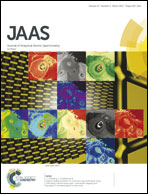Spectral emission enhancement by an electric pulse for LIBS and LAMIS
Abstract
Enhancement of the emission intensity by a secondary electric pulse following a laser ablation pulse was investigated in application to the chemical analysis by Laser-Induced Breakdown Spectroscopy (LIBS) and Laser Ablation Molecular Isotopic Spectrometry (LAMIS). A stable reheating pulsed discharge presumably sustained in a diffuse glow regime at atmospheric pressure was demonstrated as a rational approach to increase the sensitivity of the optical emission analysis over the conventional single-pulse laser ablation techniques. The enhancement in the emission intensity was illustrated by several examples of both atomic (Ca, Na) and molecular (OH, AlO, CaF) emission in LIBS and LAMIS, respectively. Especially large emission enhancement was realized for isotopologues 16OH, 18OH and 16OD at the transition A2Σ+ → X2Πi (1–0) with clearly resolved lines of their rotational branches. An increase in rotational temperature from 3370 to 4560 K was measured subsequently to the reheating of plasma by a pulsed electric discharge. Such reheating can be especially useful for the minimally destructive analysis, chemical mapping and depth profiling by LIBS. Enhancement in the emission intensity of CaF can be used for further reduction of the detection limits in fluorine determination. A brief review of the earlier publications on the cross-excitation by an electric pulse after laser ablation is provided and a comparison is made to the similar reheating of the ablation plasma in double-pulse LIBS.



 Please wait while we load your content...
Please wait while we load your content...